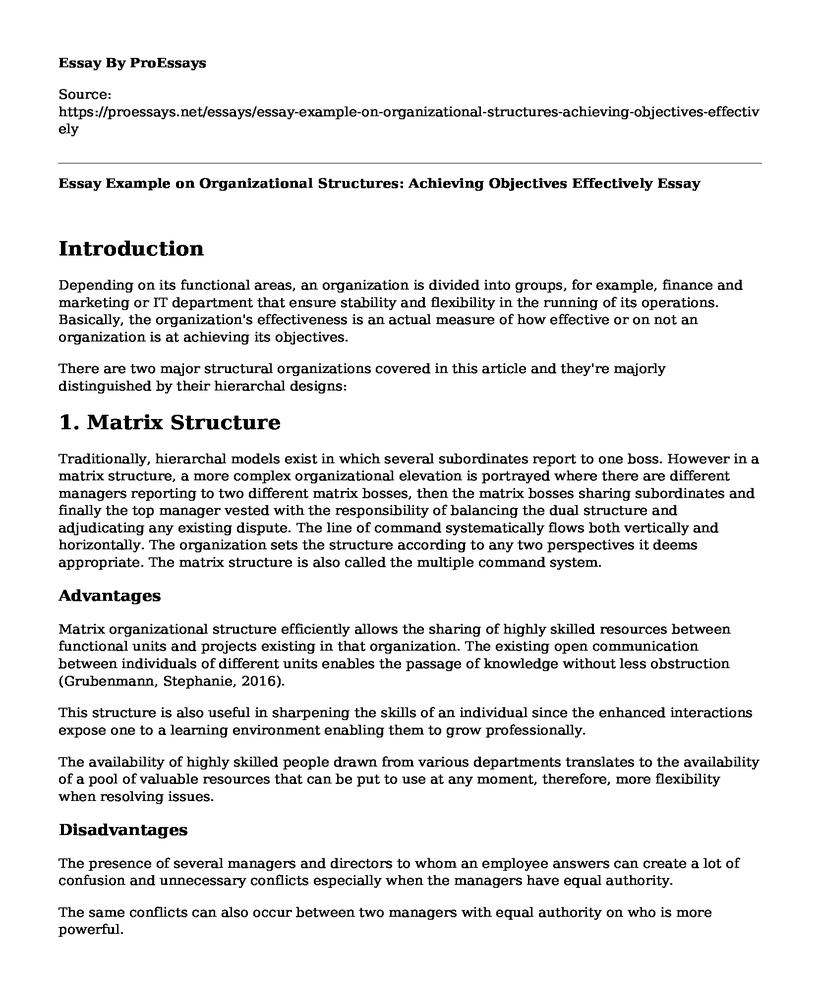Introduction
Depending on its functional areas, an organization is divided into groups, for example, finance and marketing or IT department that ensure stability and flexibility in the running of its operations. Basically, the organization's effectiveness is an actual measure of how effective or on not an organization is at achieving its objectives.
There are two major structural organizations covered in this article and they're majorly distinguished by their hierarchal designs:
1. Matrix Structure
Traditionally, hierarchal models exist in which several subordinates report to one boss. However in a matrix structure, a more complex organizational elevation is portrayed where there are different managers reporting to two different matrix bosses, then the matrix bosses sharing subordinates and finally the top manager vested with the responsibility of balancing the dual structure and adjudicating any existing dispute. The line of command systematically flows both vertically and horizontally. The organization sets the structure according to any two perspectives it deems appropriate. The matrix structure is also called the multiple command system.
Advantages
Matrix organizational structure efficiently allows the sharing of highly skilled resources between functional units and projects existing in that organization. The existing open communication between individuals of different units enables the passage of knowledge without less obstruction (Grubenmann, Stephanie, 2016).
This structure is also useful in sharpening the skills of an individual since the enhanced interactions expose one to a learning environment enabling them to grow professionally.
The availability of highly skilled people drawn from various departments translates to the availability of a pool of valuable resources that can be put to use at any moment, therefore, more flexibility when resolving issues.
Disadvantages
The presence of several managers and directors to whom an employee answers can create a lot of confusion and unnecessary conflicts especially when the managers have equal authority.
The same conflicts can also occur between two managers with equal authority on who is more powerful.
More managers also result in more expenditure being allocated to their salaries, impacting the wages of employees at the bottom of the hierarchy. This goes on to reflect on the overall expenditure incurred in maintaining the structure like keeping resources that are currently not in use but might be needed in the future.
This structure is only best applicable when the organization's operational complexity demands it, for example, a company operating in various regions with various products.
2. Virtual Network Structure
This organizational structure is formed by creating an alliance between several organizations targeting the development of a product or service, doing so by eliminating unnecessary departments and outsourcing specialized works.
Advantages
This organizational structure significantly eliminates the issue of over-departmentalization by retaining only relevant departments and outsourcing only the non-critical tasks (Kuprenas, J. A., 2003). This is also important in cutting the administrative costs since very few staff will be needed.
A great focus is put on the core areas of the work thereby enhancing efficiency and gaining even higher specialization levels and working speeds. Someone performing a particular outsourced task is already equipped with necessary skills, therefore, better performance.
This organizational structure deals with specialized jobs which give it a lot of flexibility when it comes to hiring personnel required for specialized jobs.
Disadvantages
Management of the organization is dependent on how other collaborating organizations are being managed. This means an inexperienced service provider in one department can severely alter the quality of work from other departments (Ahuja, M.K et al., 1999).
Outsourcing can lead to invoking privacy and confidentiality of sensitive information which when lost will hinder the management of the organization.
References
Ahuja, M.K., & Carley, K.M. (1999). Network structure in virtual organizations. Organization science 10 (6),741-757.
Kuprenas, J.A. (2003).Implementation and performance of a matrix organization structure. International Journal of Project Management, 21 (1), 51-62.
Cite this page
Essay Example on Organizational Structures: Achieving Objectives Effectively. (2023, May 23). Retrieved from https://proessays.net/essays/essay-example-on-organizational-structures-achieving-objectives-effectively
If you are the original author of this essay and no longer wish to have it published on the ProEssays website, please click below to request its removal:
- Time-Based Competition - Essay Sample
- Apple Inc. Marketing Plan Paper Example
- Organizational Process Assets: In-House Strategies and External Factors - Essay Sample
- Paper Example on Consumer Behavior: Reasons & Predictions for Purchasing Decisions
- Essay on Apple Inc: Tech Giant in Fiercely Competitive Consumer Electronics Market
- Vets Now's New Brand: Winning Customers' Hearts & Minds - Essay Sample
- Vancity: Achieving Competitive Advantage with Healthy Work Environment - Essay Sample







